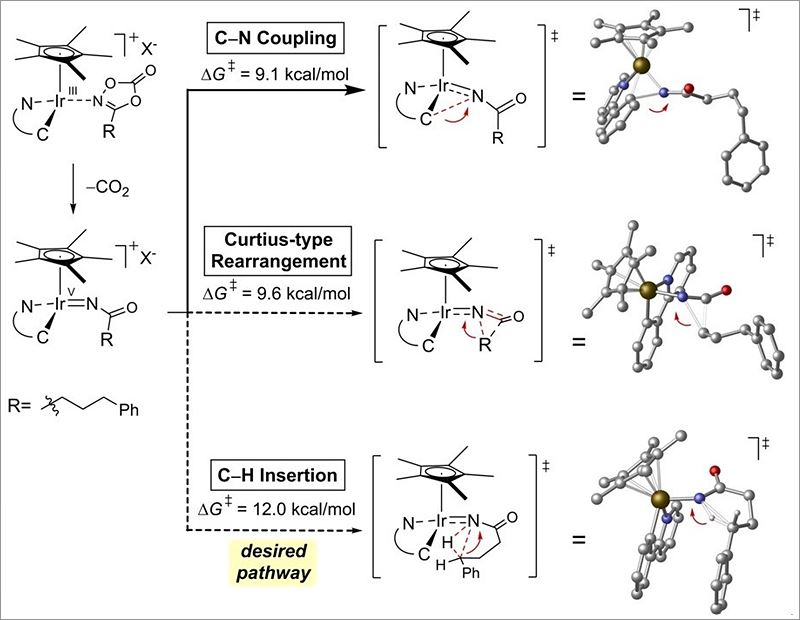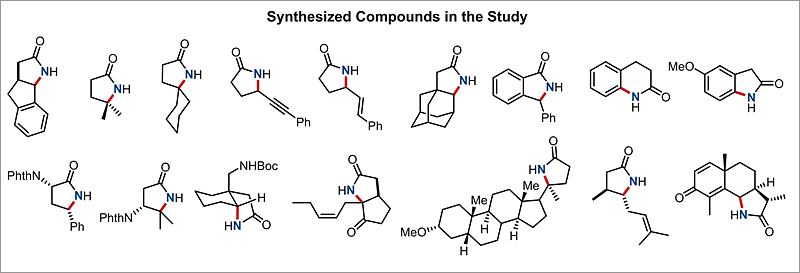A team of researchers at the Center for Catalytic Hydrocarbon Functionalizations, within the Institute for Basic Science (IBS, South Korea), have designed a novel strategy to synthesize ring-shaped cyclic molecules, highly sought-after by pharmaceutical and chemical industries, and known as gamma-lactams. This study describes how these five-membered rings can be prepared from inexpensive and readily available feedstock hydrocarbons, as well as from complex organic molecules, such as amino acids and steroids. Gamma-lactams find several applications in medicinal, synthetic, and material chemistry. For example, they are included in a large number of pharmaceutically active compounds with antibiotic, anti-inflammatory, and anti-tumoral functions. Published in Science, this research was conducted at the Korea Advanced Institute of Science and Technology (KAIST).
Conversion of hydrocarbons into nitrogen-containing compounds is an important area of research, where the challenge lies in breaking strong carbon-hydrogen (C−H) bonds, and converting them into carbon-nitrogen (C–N) bonds in a controlled fashion. For this reason, hydrocarbons are difficult to use as starting materials, albeit the fact that they exist in large quantities in nature.
Over the last 35 years, chemists have found ways of converting simple hydrocarbons into nitrogen-containing rings, such as indoles or pyrrolidines, but gamma-lactams proved impossible to prepare using the same approaches. IBS researchers hypothesized that such failure was due to alternative chemical pathways that steer the reaction away from the wanted rings: The reaction intermediate (carbonylnitrene) quickly breaks down into unsought products. Using computer models of the desired and undesired reaction pathways, the team found a strategy to completely shut down the latter in order to obtain the longed-for gamma-lactams. For the first time, these four carbons and one nitrogen cyclic molecules were obtained directly from simple feedstock chemicals.
“With this work we offer a brand new solution to a long-standing challenge and demonstrate the power of what we call mechanism-based reaction development,” explains Professor BAIK Mu-Hyun, a corresponding author of the study.

▲ Figure 1: Selective amidation reaction using newly designed iridium (Ir) catalysts. Abundant in nature Hydrocarbons are used as substrates to synthesize nitrogen-containing ring, called gamma-lactams.
Led by professor CHANG Sukbok, IBS researchers designed the winning reaction with the help of computer simulations that analyze the reaction mechanisms and calculate the energy required for the reaction to take place. According to such computer predictions, the reaction could follow three pathways, leading to the formation of either the desired gamma-lactam, an unwanted product (isocyanate), or the degradation of the catalyst caused by the substrate reacting with the catalyst backbone. Combining experimental observations and detailed computer simulations, the team designed an iridium-based catalyst, highly selective for the gamma-lactam formation. In this way, the two undesired pathways were systematically shut down, leaving the formation of the nitrogen-containing ring as the only possible outcome.

▲ Figure 2: Three possible reaction pathways and energy barriers predicted by computational chemistry. The scientists developed new iridium-based catalysts that are highly selective for the C–H insertion pathway which leads to the desired gamma-lactam molecules.
Beyond using cheap feedstock hydrocarbons as substrates, the team was also successful in converting amino acids, steroids, and other bio-relevant molecules into gamma-lactams, which might find a variety of applications as plant insecticide, drugs against parasitic worms, or anti-aging agents. This new synthetic technology gives much easier access to these complicated molecules and will enable the development of potential drugs in a much shorter amount of time at a lower cost.

▲ Figure 3: Interesting gamma-lactams derived from natural and unnatural amino acids, steroids, etc., which may be used to protect plants against insects, fight parasitic worms, or as anti-aging agents.
"In this groundbreaking work, we moved away from the existing amination strategy and opened the door to an entirely new way of turning C–H into C–N bonds. Our discovery is a paradigm changing piece of work and it offers a new conceptual foundation for many exciting developments to follow,” enthuses professor CHANG.
IBS researchers are now keen on developing less expensive catalyst systems, and expanding the range of products, for example by producing rings with four or six atoms (known as beta-lactam and delta-lactam, respectively). Finally, as explained by the first author of the study, HONG Seung Youn, the team aspires to step up from intramolecular amination reactions to intermolecular ones: “The final goal would be to achieve the direct conversion of unactivated alkanes, such as natural gases like methane or ethane gas, into useful value-added chemicals via intermolecular C-H amination.”
Letizia Diamante
Notes for editors
- References
- Reference
Seung Youn Hong, Yoonsu Park, Yeongyu Hwang, Yeong Bum Kim, Mu-Hyun Baik, and Sukbok Chang. Selective formation of γ-lactams via C−H amidation enabled by tailored iridium catalysts. Science (2018). DOI: 10.1126/science.aap7503
- Media Contact
For further information or to request media assistance, please contact: Mr. Kyungyoon Min, Head of Communications Team, Institute for Basic Science (IBS) (+82-42-878-8156, kymin@ibs.re.kr);or Ms. Carol Kim, Global Officer, Communications Team, IBS (+82-42-878-8133, clitie620@ibs.re.kr)
- About the Institute for Basic Science (IBS)
IBS was founded in 2011 by the government of the Republic of Korea with the sole purpose of driving forward the development of basic science in South Korea. IBS has launched 28 research centers as of February 2018. There are nine physics, one mathematics, six chemistry, eight life science, one earth science, and three interdisciplinary research centers.
















